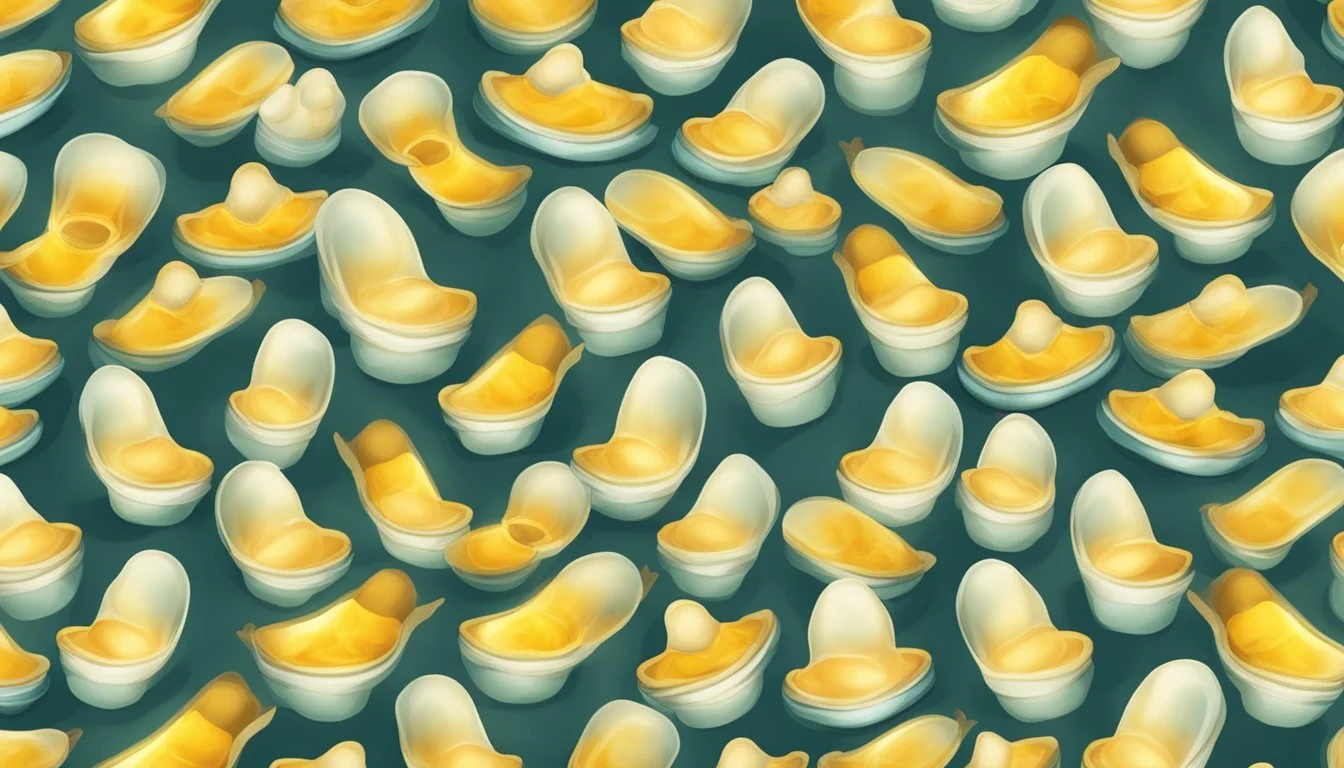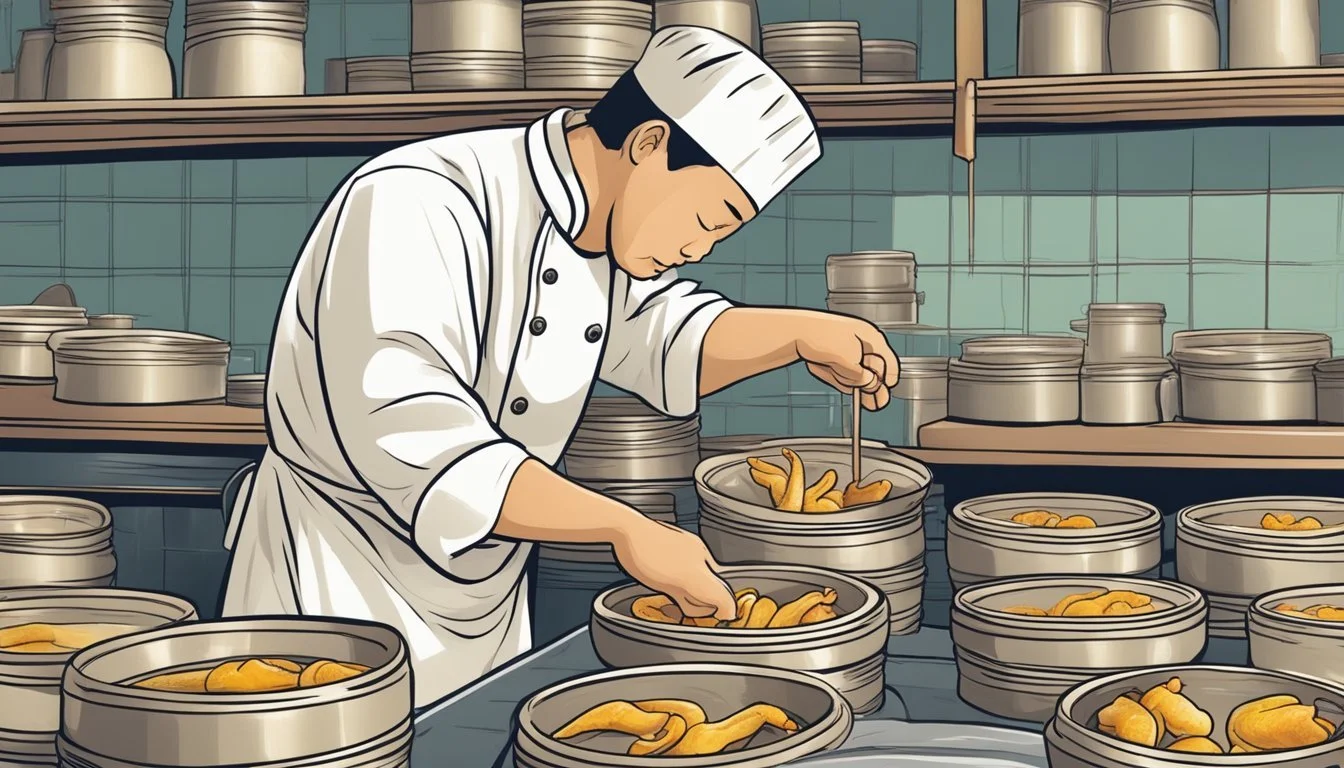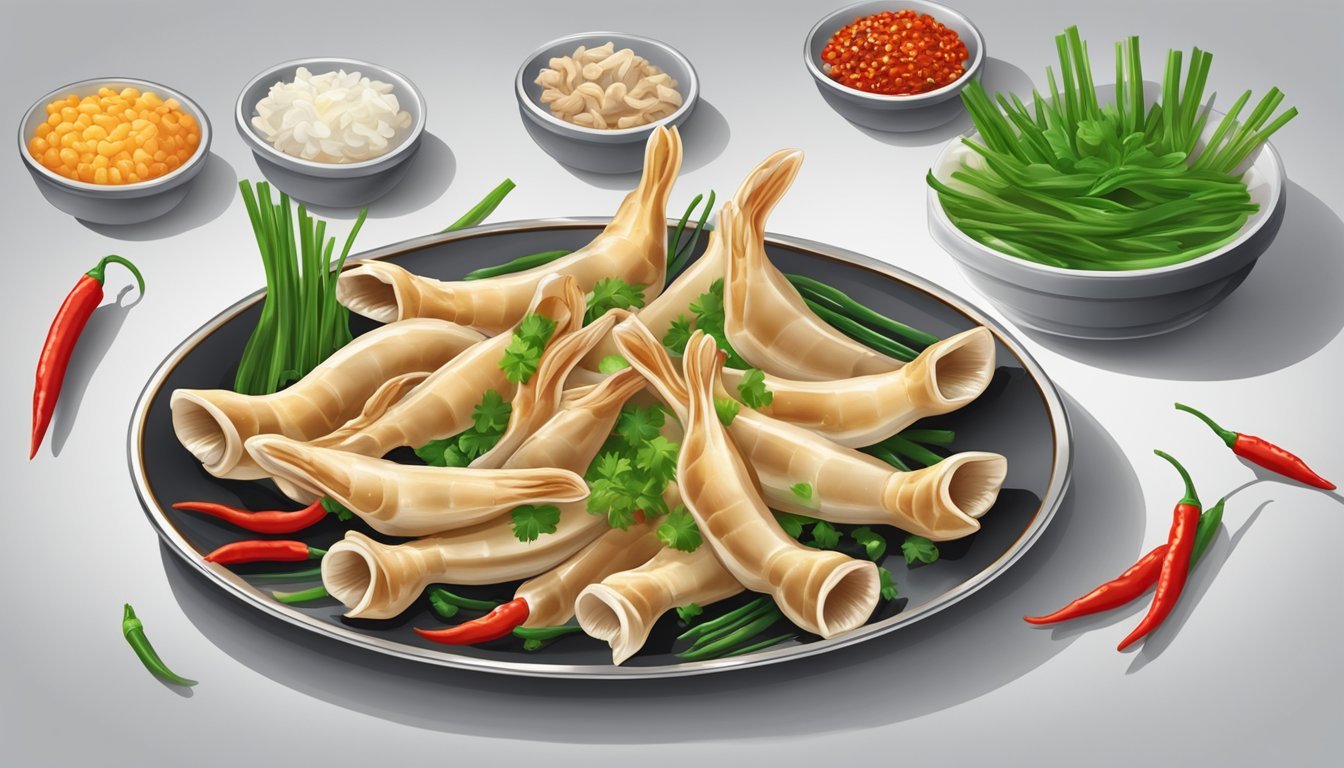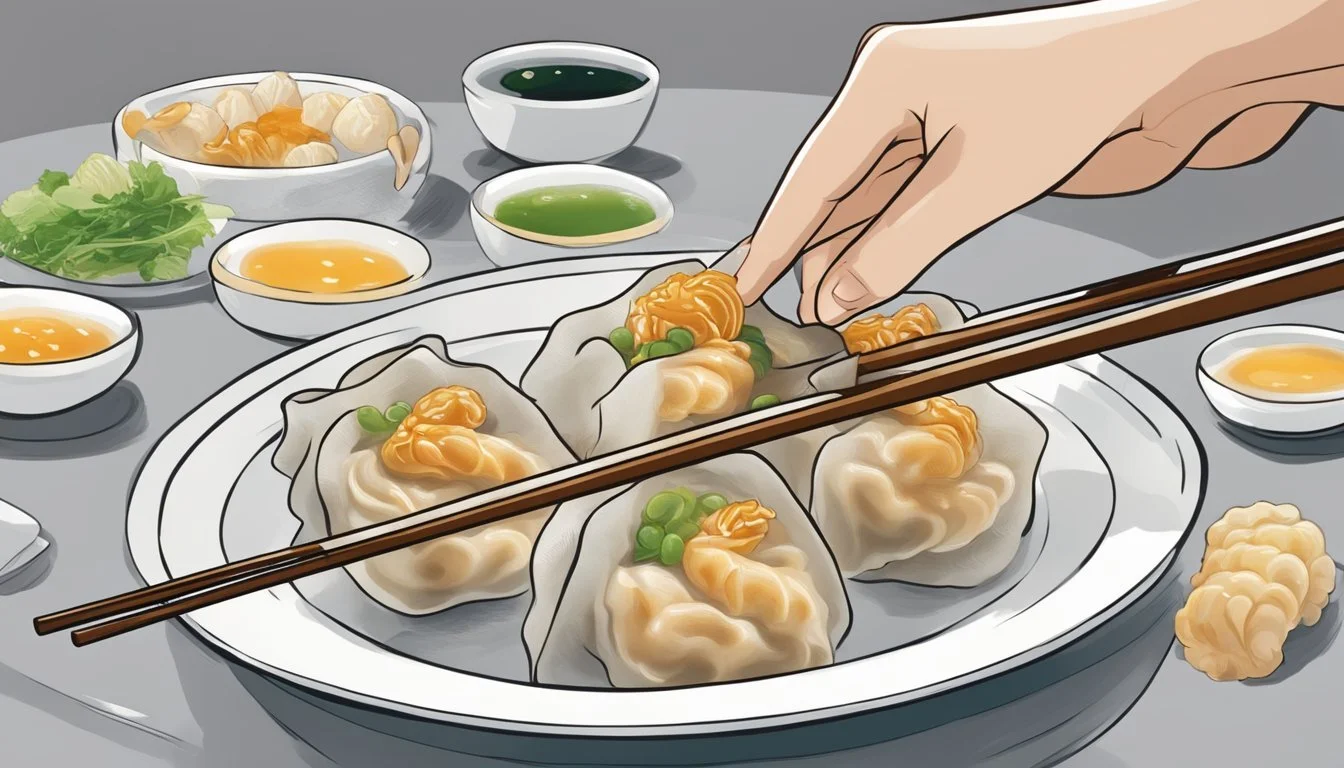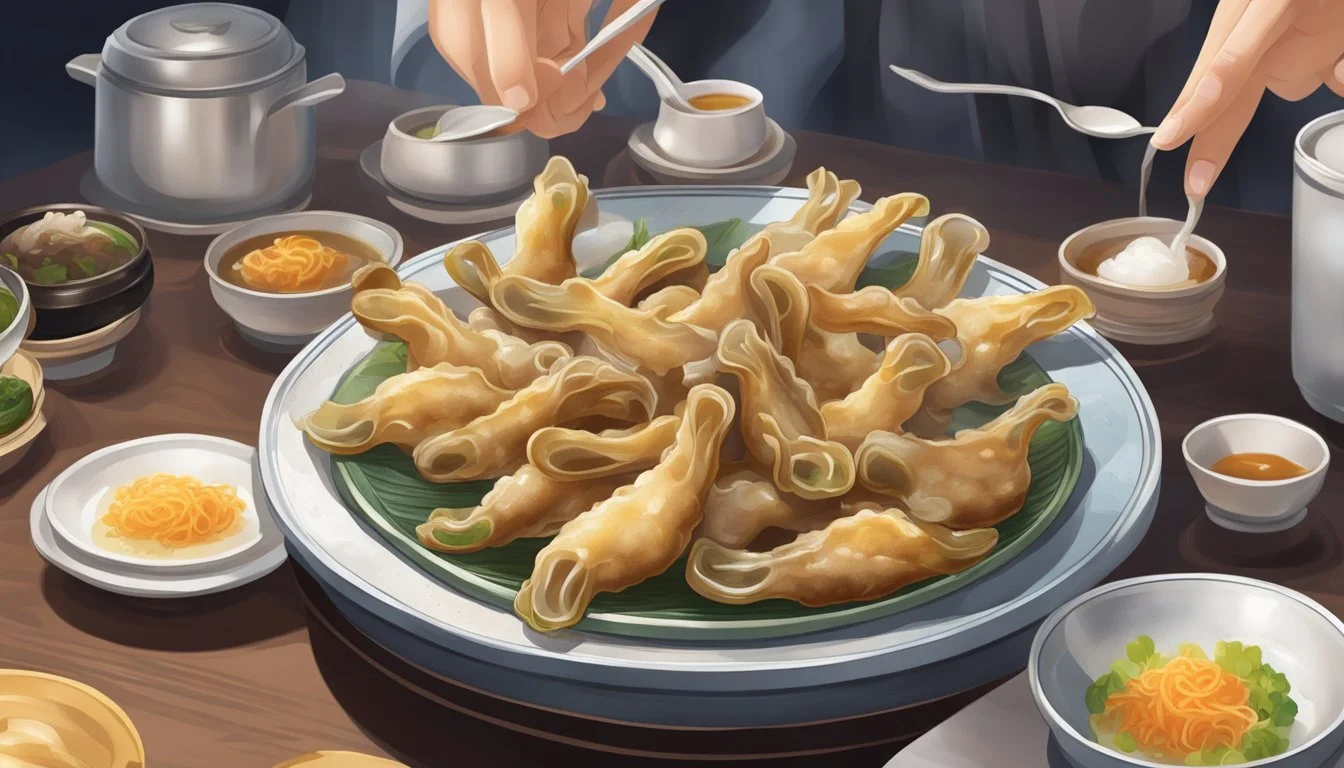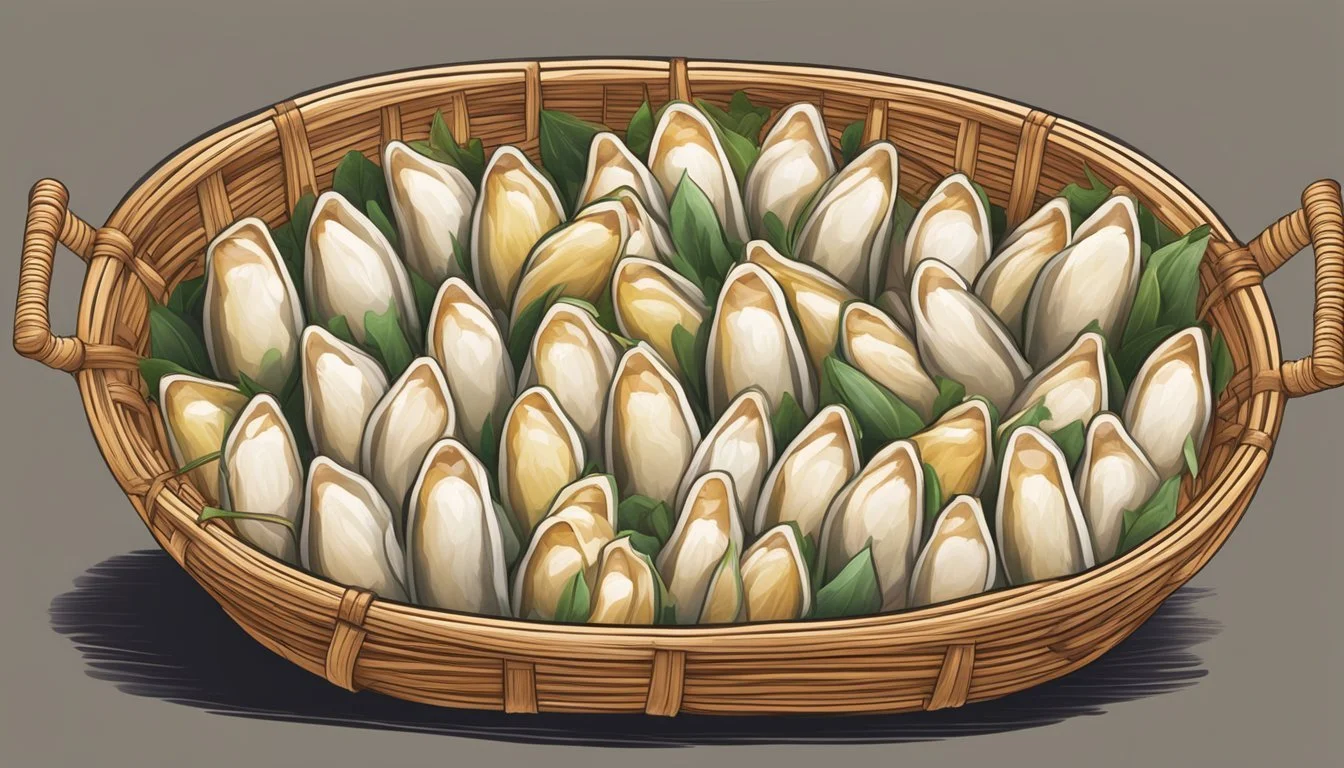Duck Feet
Savoring a Chinese Dim Sum Delight with Unique Gelatinous Appeal
Duck (What wine goes well with duck?) feet, a delicacy in Chinese cuisine, have long held a place on the dim sum menu, capturing the hearts of adventurous eaters with their unique texture and flavor. Known for their gelatinous consistency that is both intriguing and palatable, duck feet are often prepared through meticulous cooking pr ocesses that enhance their natural qualities. In the vast repertoire of Chinese culinary traditions, the preparation of duck feet has been refined to celebrate the textural interplay that is characteristic of many Chinese dishes.
Dim sum, a style of Cantonese cuisine served in small bite-sized portions, frequently features duck feet alongside a variety of other dishes. These include staples such as dumplings, buns, and rice noodle rolls. Duck feet prepared for dim sum often undergo a two-part cooking process involving first blanching and then braising or simmering in flavorful sauces. The result is a tender, flavorful dish that absorbs the essence of the combined ingredients, such as soy sauce, star anise, garlic, and fermented black beans. Duck feet not only contribute to the diversity of textures in a dim sum feast but also offer a glimpse into the complexity and depth of traditional Chinese cooking methods.
Historical Context and Origins
The tradition of serving duck feet in dim sum has its roots deeply embedded in Chinese cuisine, particularly within the Cantonese culture. Historically, the Cantonese region is known for its vast array of dim sum dishes, a practice that stems from the long-standing tea house culture of southern China.
Dim sum itself, which translates roughly to "touch the heart," began not only as a morning ritual but as a way for travelers along the Silk Road to rest and for local farmers to enjoy a hearty snack. Over time, this practice evolved into a family affair, often involving a wide range of small, shareable dishes in a communal setting.
Duck feet, known for their unique texture, became a part of this culinary tradition and are now a staple in dim sum cuisine around the world. The preparation involves:
Marinating: Typically in a blend of soy sauce, spices, and rice wine.
Braising or Steaming: Depending on the recipe, either method is used to achieve the desired tenderness.
Cooling: Necessary to develop the characteristic gelatinous texture.
These methods are consistent with the Mandarin and broader Chinese focus on texture as a crucial element of food. Duck feet might be considered an acquired taste to some, due to their distinct gelatinous quality and minimal meat, but they embody the innovation and no-waste philosophy of Chinese culinary practices. They reflect a history of cuisine that honors a variety of ingredients and techniques, marking an indelible imprint on the fabric of regional and national food culture.
Identifying Quality Duck Feet
When purchasing duck feet for culinary use, especially for the classic Chinese dim sum dish, the shopper should prioritize transparency and quality. Discerning chefs and diners recognize that the superior texture and flavor of duck feet begin with proper selection.
Appearance and Texture: One should look for duck feet that are plump and have a pale, creamy color. The skin should be smooth and free of blemishes or discolorations. A slight translucent quality is often indicative of fresh, quality duck feet, known for their gelatinous texture after cooking.
At Asian Markets:
Inspect the duck feet on display carefully to ensure they are fresh.
Asian markets are more likely to stock fresh duck feet, as they are common in regional recipes.
Buying from Butchers:
Opt for a reputable butcher known for supplying fresh poultry products.
Articulate the intent to use duck feet in dim sum to get the best advice and quality.
Freshness:
The freshness can often be determined by a subtle aroma; it should not be overly pungent or unpleasant.
Fresh duck feet are typically more pliable. Rigidity may suggest they are not as fresh.
Storage and Handling:
Ensure the feet have been stored at safe temperatures. They should be refrigerated or on ice when purchased.
Proper handling during selection is also vital. Butchers at Asian markets usually observe hygienic practices, wearing gloves while handling the meat.
By carefully selecting duck feet from trusted sources and inspecting them for these quality indicators, the foundation for a savory, gelatinous Chinese dim sum dish is set.
Preparation Methods
In crafting duck feet into a Chinese dim sum delight, precision and patience are vital from the initial cleaning to the final presentation. This section delineates the step-by-step procedures that are essential to transform simple ingredients into an appetizing dish with a perfectly gelatinous texture.
Cleaning and Blanching
Duck feet must be washed thoroughly under cold water. Clipping off toenails and getting rid of any remaining feathers is paramount to cleanliness. The feet are then blanched in boiling water for about 3 to 5 minutes, a crucial step to eliminate impurities. Immediately after, they are placed in ice water to halt the cooking process and to make peeling off the tough outer skin easier.
Marinating Techniques
Post-cleaning, the duck feet are marinated to infuse them with flavors. A typical marinade might include soy sauce, oyster sauce, rice wine, sugar, salt, and an array of spices such as ginger and star anise. The duck feet are usually left in the marinade for several hours, allowing the flavors to permeate the cartilage and skin.
Braising Duck Feet
Braising is a slow cooking method that tenderizes the duck feet. For this, a braising liquid made of soy sauce, rice wine, sugar, and a blend of spices like cloves, star anise, and cinnamon is prepared. Duck feet are cooked in this seasoned broth under low heat to achieve the desired tenderness and taste.
Steaming Procedures
Steaming is an alternative cooking method where the marinated duck feet are placed over boiling water, allowing the steam to cook them through. The moisture retained during steaming ensures the feet remain succulent. Aromatic ingredients such as green onions (What wine goes well with onions?) and cilantro are sometimes added to the steamer to enhance the fragrance.
Final Touches and Presentation
Once tender, the duck feet are coated lightly with cornstarch, which provides a slight thickness to the surrounding sauce upon heating. This addition contributes to the gelatinous texture that's characteristic of the dish. The duck feet can then be artfully arranged on the serving plate, ready for presentation.
Serving Suggestions
Duck feet in dim sum cuisine are traditionally served with other dim sum items, like steamed buns, rice noodle rolls, and dumplings. They're often presented on small plates or in steamer baskets, accompanied by fresh, steamed vegetables like bok choy to offer a balanced palette of flavors and textures.
Sauce Accompaniments
Sauce complementation is critical for adding depth to the duck feet's subtle flavors. Popular sauces include fermented black bean sauce, which introduces a savory umami element; the sweet and salty hoisin sauce; and spicy chili sauce for an added kick. These sauces can be offered on the side or drizzled over the top just before serving.
Ingredient Breakdown
When preparing Duck Feet, the choice of ingredients is essential to creating the authentic flavor and texture of this Chinese Dim Sum classic. The dish is characterized by a gelatinous texture and a flavorful, savory sauce.
Common Aromatics
In Chinese cooking, aromatics are foundational for imparting a deep, rich flavor. Duck feet dishes often include:
Garlic: Adds a sharp, slightly spicy flavor.
Onions and Green Onions: Provide a sweet yet pungent undertone.
Ginger: Offers a unique warmth with a spicy, earthy note.
Essential Sauces and Condiments
A balanced mix of sauces and condiments is crucial for the complex sauce enveloping the duck feet. These include:
Soy Sauce: Used for its salty, umami flavor.
Oyster Sauce: Gives a richer depth due to its thick, sweet, and savory profile.
Hoisin Sauce: Adds sweetness along with a garlicky kick.
Sesame Oil: Brings a nutty and aromatic finish to dishes.
Sugar: Often used to balance the saltiness of soy sauce.
Key Spices and Herbs
Spices and herbs significantly contribute to the dish’s distinctive taste. The most common ones include:
Cinnamon and Star Anise: These spices often infuse the stock with warm, sweet, and aromatic flavors.
Salt: Regulates the overall flavor intensity.
Sesame Seeds: Garnish for a mild, sweet, and nutty taste.
Stock, enriched with bones, forms the base of the dish, while rice wine is typically added to the cooking process to enhance flavor with its mild sweetness and to tenderize the duck feet.
Culinary Techniques and Terms
This section delves into the essential culinary techniques and terms employed in the preparation of duck feet, a classic dish in Chinese dim sum. The focus will be on braising, blanching, marinating, and the use of thickening agents, which are pivotal in achieving the gelatinous texture characteristic of this delicacy.
Understanding Braising
Braising is a slow cooking method that transforms duck feet's tough connective tissues into a tender, gelatinous texture. The process involves initially searing the feet in hot oil, then slowly cooking them in a seasoned liquid, such as a combination of stock, soy sauce, and traditional spices. The braising liquid infuses the meat with flavor and moisture.
Technique of Blanching
Prior to braising, blanching is a preparatory step crucial for both cleaning the duck feet and ensuring a refined taste. Blanching involves submerging the feet in boiling water briefly before shocking them in cold water. This technique helps remove impurities and any unpleasant smell from the bones and cartilage, preparing them for further cooking.
Art of Marinating
Marination is the process of soaking the duck feet in a flavorful mixture which can include soy sauce, rice wine, sugar, and a variety of spices like five-spice powder or Szechuan peppercorns. Marinating not only seasons the duck feet but also tenderizes them, enhancing the overall taste and texture of the finished dish.
Thickening Agents
Thickening agents, such as cornstarch or flour, are used at the final stages of the cooking process to create a glossy and slightly thickened sauce. A slurry made with these agents is mixed into the braising liquid, which gently coats the tender duck feet, providing a rich, velvety finish that is visually appealing and palate-pleasing.
Nutrition and Health
Duck feet, a staple in Chinese dim sum, offer unique nutritional benefits especially due to their high collagen content. These savory morsels are treasured not only for their gelatinous texture but also for their health implications.
Calcium Content and Benefits
Duck feet are a source of Calcium, an essential mineral for bone health and strength. Regular consumption can contribute to the maintenance of normal bones and teeth. The gelatinous texture of duck feet is indicative of their rich collagen content, which is a beneficial protein that supports joint and skin health.
Considerations in Diet
When incorporating duck feet into the diet, it is crucial to consider the overall balance of nutrition. They can be high in sodium, especially when prepared with soy sauce which contains gluten. Those on a low-sodium or gluten-free diet should be aware of how duck feet are seasoned and seek out or prepare versions that align with their dietary restrictions.
Low Sodium Option: Opt for reduced-sodium soy sauce or alternative seasonings.
Gluten-Free Option: Verify that tamari or gluten-free soy sauce is used if gluten sensitivities are a concern.
Allergies and Sensitivities
Duck feet may not be suitable for everyone, and individual allergies and sensitivities should be taken into account. They are a potential allergen for those sensitive to poultry. Additionally, the high gelatin content, while beneficial for some aspects of health, may not be compatible with certain dietary preferences or restrictions, such as a vegetarian or vegan lifestyle.
Allergens: Poultry allergies need to be considered.
Dietary Preferences: Not suitable for vegetarian or vegan diets due to animal collagen.
Duck Feet in Popular Culture
Duck feet, traditionally savored in many Asian cultures, particularly Chinese, have carved their unique niche in the sphere of contemporary gastronomy due to their distinctive gelatinous texture. They are principally observed as a staple in dim sum restaurants, where a variety of other culinary delights such as siu mai (pork dumplings) (What Wine Pairs Best with Pork Dumplings) and char siu bao (barbecue pork buns) accompany them. The dish is an entity of social dining experiences, often shared on lazy Susan tables amidst tea and conversation.
Within the cinematic universe and literature, it is not uncommon for scenes to unfold in the bustling ambiance of a dim sum restaurant where dinettes are seen indulging in duck feet—often highlighted as a symbol of authenticity and traditional fare. They occasionally appear in travel shows, representing an adventurous choice for hosts willing to explore intricate aspects of culinary traditions.
Furthermore, celebrities and food influencers sometimes act as cultural ambassadors for these dishes, introducing duck feet to audiences who may not be familiar with them, thereby broadening their cultural influence. Roast duck, a close sibling, enjoys prominence on screen, often shown hanging in the windows of Chinese restaurants—a familiar sight to many viewers.
Here's a brief overview illustrating the cultural presence of duck feet:
Dim Sum Restaurant: An establishment serving small plates, including duck feet.
Siu Mai and Char Siu Bao: Duck feet usually share the menu with these popular items.
Roast Duck: While different, it often accompanies duck feet in a traditional course.
As the world's palate becomes more globalized, the presence of duck feet on mainstream food platforms is a clear indicator of their sustained influence in popular culture.
Acquiring and Storing Duck Feet
When sourcing duck feet, patrons often turn to Asian markets or local butchers known for their supply of diverse meats. Duck feet, an integral component of traditional Chinese dim sum, are typically sold fresh, frozen, or in some cases, pre-cooked in Asian grocery stores. Freshness is key, so consumers should inspect the feet for any signs of spoilage or an off odor, ensuring a high-quality selection for their recipes.
Storage of duck feet, once acquired, is critical to maintaining their quality and safety for consumption. Below are some effective methods of storage:
Refrigeration: If the duck feet are fresh, refrigeration is appropriate for short-term storage. Patrons should place them in a tightly sealed container or wrap them in plastic wrap and consume them within two days.
Freezing: For longer storage, freezing is recommended. They can be stored in freezer bags or airtight containers, clearly labeled with the date of storage. Properly frozen duck feet can be kept for several months.
Storage Method
Refrigeration
Duration: Up to 2 days
Container Type: Sealed container/plastic wrap
Freezing
Duration: Several months
Container Type: Freezer bags/airtight containers
Before using, defrosting should be done gradually in the refrigerator to ensure that the duck feet maintain their quality and prevent the growth of bacteria. It is important to note that once thawed, the duck feet should not be refrozen and should be cooked promptly.
Advanced Cooking Tips
When cooking duck feet, a savory outcome is the goal. Achieving this involves a balance of spices and seasoning. Here is a breakdown of how one can enhance the flavor profile and texture:
Braising: For deep flavors, one should braise the duck feet over medium heat using a combination of seasonings. Soy sauce offers a rich umami base, while a touch of sugar aids in caramelization.
Spices: Star anise and cinnamon can be included to infuse complexity. Wrap these spices in cheesecloth for easy removal after cooking.
Tenderizing: Duck feet contain collagen, which requires prolonged cooking to achieve the desired gelatinous texture. Simmering for 1.5 to 2 hours is advisable.
Seasoning: Adjust seasoning post-braising to ensure the savory profile of the dish stands out. Be wary of overpowering the delicate flavors with too much salt or other dominant seasonings.
Here's a concise list of the essential Tips for mastering duck feet preparation:
Cleaning: Thoroughly wash the feet and clip off toenails to prepare.
Blanching: Blanch in boiling water to remove impurities.
Seasoning: Balance soy sauce, sugar, and a hint of sesame oil for an optimal savory taste.
Cooking: Gently simmer the feet until they are tender, checking the tenderness at regular intervals.
By adhering to these guidelines, one ensures that the duck feet dish preserves its traditional character while maximizing flavor and texture.
Pairings and Variations
Duck feet, a Chinese dim sum staple, are noted for their unique gelatinous texture and rich flavor. When it comes to pairings, selecting complementary items that enhance the taste and experience is key.
Ideal Pairings:
Rice Noodle Rolls: Their smooth, soft texture contrasts pleasantly with the chewiness of duck feet, providing a balance in mouthfeel.
Shrimp: It pairs well due to its delicate sweetness, adding a seafood flavor that complements the depth of duck feet.
Mushrooms: Known for their umami properties, mushrooms elevate the savoriness when served alongside duck feet.
Bok Choy: This green vegetable offers a crisp, fresh counterpoint to the rich and densely textured duck feet.
Suggested Variations:
Steamed Variations:
Steamed with black bean sauce to infuse a savory and slightly spicy tone.
Glazed Variations:
Glazed with a soy-based reduction and served with steamed greens for an enhanced flavor profile.
Fried Variations:
Lightly fried and then simmered in a master stock containing star anise and cinnamon for an aromatic twist.
Wine Pairing:
Lighter-bodied white wines, which will not overpower the dish's distinctiveness, can be an excellent choice.
Non-Alcoholic Alternatives:
For a non-alcoholic option, chilled jasmine tea provides a floral aroma that can cut through the richness of the duck feet.
By thoughtfully combining duck feet with the above suggestions, diners can enjoy a more rounded dim sum experience that plays with textures, flavors, and aromas.
Handling Leftovers
When managing leftovers of duck feet from dim sum, proper storage is crucial to maintain their quality and safety. Duck feet should be placed in an airtight container within two hours of cooking to avoid bacterial growth. They can be stored in the refrigerator for up to three to four days. For longer preservation, freezing is an option, and they can last up to a month when frozen correctly.
To reheat refrigerated duck feet, one should ensure even warming to retain their gelatinous texture. A steamer works best, gently heating the duck feet until they are thoroughly warmed through, which usually takes about 10 minutes. It is important not to overheat as this can affect their unique texture.
For those who have frozen their leftovers, it's recommended to thaw them in the refrigerator overnight before reheating. Direct reheating from frozen in a steamer can be done but may require a longer time, up to 20 minutes, to ensure they are heated evenly.
Reheating Guidelines:
Refrigerated duck feet: Steam for about 10 minutes.
Frozen duck feet: Thaw overnight and steam for 10 minutes, or steam directly for about 20 minutes.
Here's a brief list summarizing the key points:
Store in an airtight container and refrigerate for 3-4 days or freeze for up to a month.
Reheat using a steamer to keep the texture intact.
Avoid overheating to prevent texture changes.
Thaw frozen leftovers in the refrigerator before reheating for best results.
Glossary of Terms
This section is dedicated to clarifying key culinary and linguistic elements associated with duck feet in Chinese dim sum. Learning these terms will enhance your understanding of this traditional dish and its cultural context.
Dim Sum-Related Terms
Dim Sum: A variety of small dishes served in Chinese cuisine, particularly Cantonese, intended to be shared and often enjoyed with tea.
Char Siu Bao: Steamed buns filled with barbecued pork.
Siu Mai: Open-topped steamed dumplings usually filled with minced pork and shrimp.
Cooking and Cuisine Terms
Braise (红烧): A cooking method where food is first fried lightly and then stewed slowly in a covered pot with a moderate amount of liquid.
Marinate (腌制): To soak foods in a flavorful liquid before cooking to enhance their flavor.
Steam (蒸): To cook food using steam without immersing it in water, keeping its shape and texture.
Duck Broth: A flavorful liquid made by simmering duck bones and aromatic ingredients, often used to enrich the flavor of dishes.
Ingredient Names in Mandarin
Duck Feet (鸭脚 - yā jiǎo): The feet of ducks, considered a distinctive ingredient in Chinese cuisine for their unique gelatinous texture.
Taro (芋头 - yùtóu): A starchy root vegetable often found in dim sum dishes for its nutty flavor.
Rice Wine (米酒 - mǐjiǔ): An alcoholic liquid made from fermenting rice, used in cooking to add flavor and depth.
Soy Sauce (酱油 - jiàngyóu): A condiment made from fermented soybeans, used to add a salty and umami flavor to dishes.
Frequently Asked Questions
What is the correct way to pronounce "Duck Feet" in the context of Chinese cuisine?
The term "Duck Feet" in Chinese can be pronounced as "Yā Jiǎo." It refers to a traditional delicacy often served in dim sum restaurants.
How do you achieve the sought-after gelatinous texture in a Duck Feet Recipe?
The gelatinous texture is obtained through slow braising. Duck feet contain high levels of collagen, which transforms into a gelatinous consistency when cooked for an extended period, often 1.5 to 2 hours on a low simmer.
Can you give a brief overview of the Cooking Process for Braised Duck Feet?
Here's a brief step-by-step guide:
Prepare the Feet: Wash thoroughly and clip off toenails.
Blanch: Boil in water for 3-5 minutes to remove impurities.
Marinate: Season with flavors like cooking wine, sesame oil, chicken powder, and sugar.
Braise: Cook in a flavorful liquid on a medium heat, ensuring the feet are submerged, for up to 50 minutes.
Tenderize: Continue to simmer on low heat until the feet are tender, checking after 1.5 hours.
Are there any variations in the Duck Feet Recipe?
Yes, recipes can vary with different seasonings and methods. Some may brown the feet first with sugar for a richer color, while others may focus solely on braising with savory ingredients like soy sauce and spices.
Is there a standard set of ingredients for the Braising Liquid in Duck Feet Recipes?
While ingredients can vary, a common braising liquid might include cooking wine, sugar, soy sauce, and spices such as star anise. The balance of savory and sweet flavors is key to an authentic recipe.
Conclusion
Duck feet, a component in Chinese cuisine, particularly within the realm of Dim Sum, offers diners a unique experience. Through meticulous preparation, they are transformed into a dish with a gelatinous texture that intrigues the palate. The process generally involves an initial cleaning, followed by a combination of cooking techniques including marination and braising.
Key aspects to consider when preparing duck feet for Dim Sum:
Cleaning: They must be washed and prepped properly.
Texture: Achieved through precise cooking methods.
Flavor: Enhanced by a savory sauce that often includes ingredients such as bean paste, soy sauce, and spices, elevating the dish's taste profile.
The result is a dish that reflects an integral facet of Dim Sum—variety and complexity of flavors wrapped in bite-sized portions. It is essential to acknowledge that while duck feet may not be a common dish in Western cuisine, they are a staple in Chinese banquets and Dim Sum dining.
Table Highlighting the Cooking Sequence for Duck Feet:
Cleaning: Ensure purity and readiness for marination
Marination: Infuse flavors and tenderize
Cooking: Achieve desired texture through braising or steaming
Sauce Coating: Adds a layer of savory taste
In conclusion, duck feet represent traditional Chinese culinary practices and the embracing of diverse textures in food. For adventurous diners, it's an opportunity to explore this classic component of Dim Sum, which encapsulates the rich tapestry of Chinese cuisine.

